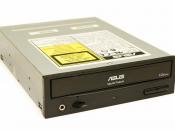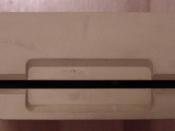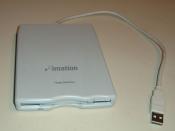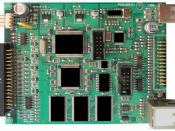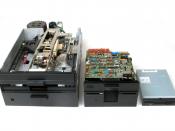The introduction of information systems has revolutionized the way of life. No longer are the days of handwritten letters, typewriters, and filing papers. Although revolutionary, an information system is only as good as its components; input devices, output methods, storage devices, and speed.
Input DevicesData input is important because the accuracy of output depends on the accuracy of the input; inaccurate information can lead to problems. To reduce the error and inefficiency of human input, input devices are often used. The best method of data input depends on the type of situation and the needs of the user.
Printed DocumentsThe best method of data input for printed documents such as questionnaires and long documents would be special scanning devices called Optical Data Readers which allow for documents to be scanned. Questionnaires can be scanned with optical mark recognition (OMR) devices. Long documents can be scanned with optical character recognition (OCR) devices.
Using optical data readers will reduce the amount of time needed and errors caused by manual human input.
Telephone SurveyTelephone surveys require representatives to input responses. The best method for telephone surveys would be the combination of Terminals and Voice-Recognition Devices at the call centers. Terminals are inexpensive and easy to use and can be places in several types of locations such as offices, warehouses, and on factory floors. Voice-recognition devices ÃÂuse microphones and special software to record and convert the sound of the human voice into digital signalsÃÂ (Stair & Reynolds, 2006, p. 57). The use of voice-recognition devices increases efficiency and reduces the risk of carpal tunnel syndrome, thus reducing workers compensation claims.
Bank ChecksFinancial institutions use Magnetic Ink Character Recognition (MICR) devices to process bank checks and other documents quickly and efficiently. The use of MICR devices ÃÂspeeds the collection of checks, improves the availability of funds, reduces fraud losses, and lowers collection costsÃÂ (Stair & Reynolds, 2006, p. 59) by reading data printed in special magnetic ink at the bottom of the document.
Retail TagsData input for retail tags can be achieved with Point-of-Sale (POS) devices and Bar-Code Scanners. The POS device and bar-code scanners assist in inventory control, while the POS also calculates the charges of the transaction. Bar-code scanners are useful in situations where the merchandise is too large, such as major appliances or large televisions, to be processed at the POS device.
Output MethodsThe convenience and quality of the output are important because they will aid in the decision-making process. Output can be in various forms such as audio, visual, and digital. The following situations require visual output in different forms.
The best method of output for hand held computers are Organic Light-Emitting Diodes (OLEDs) for immediate viewing. OLEDs provide brighter and sharper colors, do not require a backlight, are ÃÂhalf the thickness of OCDs,ÃÂ and ÃÂdo not break when droppedÃÂ (Stair & Reynolds, 2006, p. 60). Color photographs, resumes, memorandums, statistical reports, and company annual reports are best viewed in hardcopy format via printer. As technology is advancing quickly, the most common alternate form of viewing output has become digital via monitor, LCD, or OLEDs. The digital format has become equally as important as a hardcopy because it reduces the costs associated with processing and time.
Storage DevicesThe type of storage device that is optimal for the situation is dictated by the needs of the user. Nearly all computers and servers contain at least one hard disk. A hard disk is a permanent, non-volatile storage device that holds all the information available on a computer that is not lost when the power is out. The hard disk can be considered the long-term memory. Random Access Memory (RAM) allows programs and operating systems to run at high speeds. If the computer had to constantly access the hard drive to retrieve the necessary information, it would run very slowly. RAM can be considered the short-term memory.
Floppy disks were previously used as an inexpensive means to store a computerÃÂs operating system, applications, and data. The disks were popular in the 1970s through the 1990s until the introduction of Compact Disc Read-Only Memory (CD-ROMs). Floppy disk drives are no longer standard components in new computers unless requested. CD-ROMs, which are now ubiquitous, can be used for data, video, and audio storage with the capacity to store 650-900 megabytes (MB). CD-ROMs are appropriate for the storage and distribution of data, software and applications.
Because magnetic tapes are less expensive then disk storage, they are ÃÂoften used to back up disk drives and store data off-site for recovery in case of disasterÃÂ (Stair & Reynolds, 2006, p.53). Flash/jump drives have become useful for all users who need to have data readily accessible. Flash/jump drives are excellent portable storage devices because they are compact, store up to 64 gigabytes (GB), durable, and rewriteable.
SpeedMany factors play a role in determining the speed of a computer. RAM allows programs and operating systems to run at high speeds, the greater the RAM, the faster a computer can access the memory to start or run applications. Clock speed is the speed in which a computer executes the instructions; the greater the clock speed, the faster instructions are executed. Hard disks give direct access to stored data; the faster the hard disk, the faster it can load programs. The speed of the CD-ROM has virtually no impact on the speed of the computer unless installing software or burning a file to disk. The floppy disk speed also nothing to do with the speed of the computer.
ConclusionIn order for an information system to process data quickly, effectively, and efficiently, it relies on its system components. Individually the components have no effect. Together they process data quickly and efficiently to allow individuals to make decisions and solve problems.
ReferencesStair, R. M., & Reynolds, G. W. (2006). Fundamentals of information systems (3rd ed.). Boston: Course Technology.
